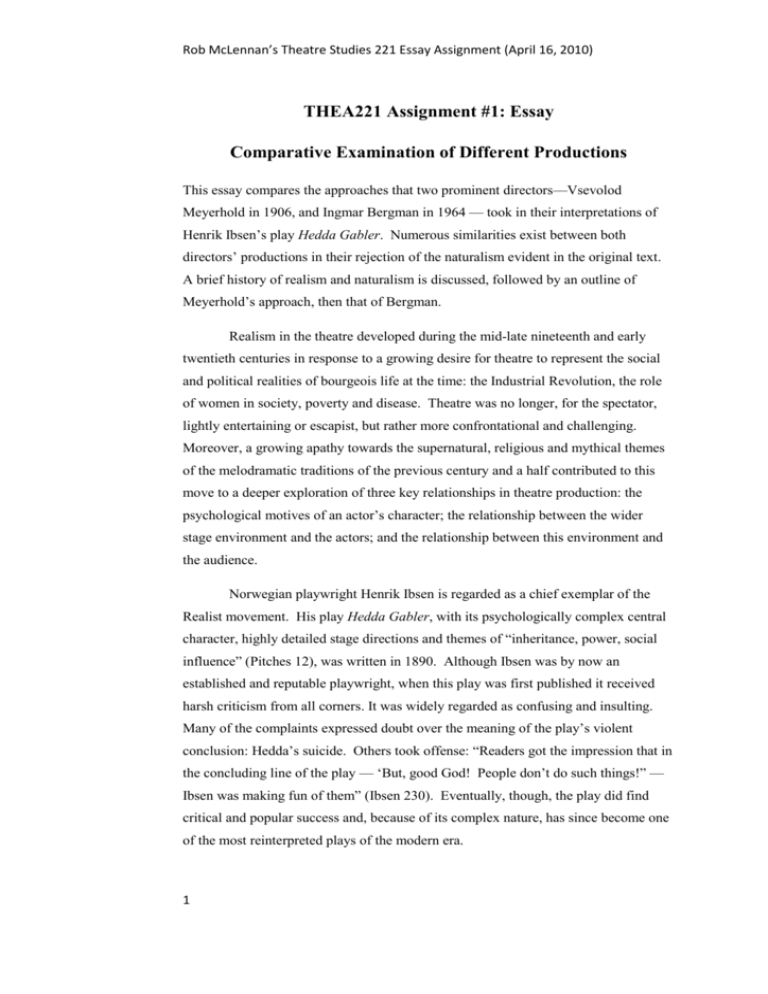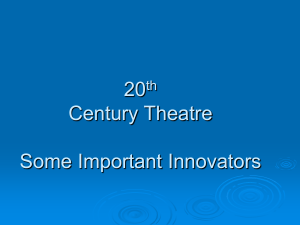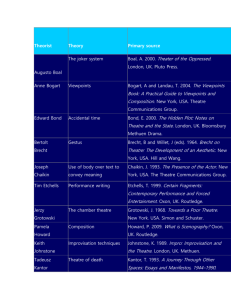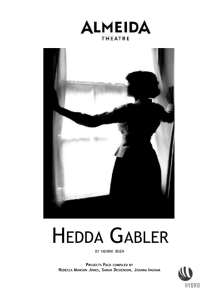Rob McLennan - WordPress.com
advertisement

Rob McLennan’s Theatre Studies 221 Essay Assignment (April 16, 2010) THEA221 Assignment #1: Essay Comparative Examination of Different Productions This essay compares the approaches that two prominent directors—Vsevolod Meyerhold in 1906, and Ingmar Bergman in 1964 — took in their interpretations of Henrik Ibsen’s play Hedda Gabler. Numerous similarities exist between both directors’ productions in their rejection of the naturalism evident in the original text. A brief history of realism and naturalism is discussed, followed by an outline of Meyerhold’s approach, then that of Bergman. Realism in the theatre developed during the mid-late nineteenth and early twentieth centuries in response to a growing desire for theatre to represent the social and political realities of bourgeois life at the time: the Industrial Revolution, the role of women in society, poverty and disease. Theatre was no longer, for the spectator, lightly entertaining or escapist, but rather more confrontational and challenging. Moreover, a growing apathy towards the supernatural, religious and mythical themes of the melodramatic traditions of the previous century and a half contributed to this move to a deeper exploration of three key relationships in theatre production: the psychological motives of an actor’s character; the relationship between the wider stage environment and the actors; and the relationship between this environment and the audience. Norwegian playwright Henrik Ibsen is regarded as a chief exemplar of the Realist movement. His play Hedda Gabler, with its psychologically complex central character, highly detailed stage directions and themes of “inheritance, power, social influence” (Pitches 12), was written in 1890. Although Ibsen was by now an established and reputable playwright, when this play was first published it received harsh criticism from all corners. It was widely regarded as confusing and insulting. Many of the complaints expressed doubt over the meaning of the play’s violent conclusion: Hedda’s suicide. Others took offense: “Readers got the impression that in the concluding line of the play — ‘But, good God! People don’t do such things!” — Ibsen was making fun of them” (Ibsen 230). Eventually, though, the play did find critical and popular success and, because of its complex nature, has since become one of the most reinterpreted plays of the modern era. 1 Rob McLennan’s Theatre Studies 221 Essay Assignment (April 16, 2010) One of the most noteworthy of these reinterpretations came from Russia in 1906, where Vsevolod Meyerhold, in partnership with actress Vera Kommisarjevskaya (who played the role of Hedda), premiered the Ibsen play at the Komissarzhevskaya Theatre in St Petersburg. Meyerhold strongly believed that Hedda Gabler was meant to be, as he put it, ‘stylised theatre’; an opportunity to present Ibsen’s play in new and unfamiliar ways. Speaking about Ibsen’s original text, Meyerhold protested, "Life is not like this, and it is not what Ibsen wrote" (Pitches 13). The features of stylised theatre included particular focuses on the actors and their movement and expression; minimal props and scenery; the encouragement of the spectator to use their own imagination; the freedom for the director to modify the playwright’s original words; and the careful, painting-like construction of the aesthetics of the production. In an overt departure from naturalistic theatre, the set for Meyerhold’s Hedda Gabler was curiously minimalistic. A large decorative background panel was used to capture the essence of the whole drama. According to Samuelsen, most of the action took place around Hedda, who was seated in a centrally placed, oversized “throne-like chair” which was covered with white fur (12). Other significant stage items were a white grand piano, a hanging window, lace curtains through which actors entered — Meyerhold had dispensed altogether with doors — and “a two dimensional painted backdrop” (12). Using a conspicuously shallow stage area (thirty feet wide but only twelve deep), Konstantin Rudnitsky adds, "Meyerhold was striving to move the action as close as possible to the audience, but the stage was not extended in width, the scenes were primarily in the centre, the characters were ‘very tightly grouped together’” (101). These configurations, which Meyerhold used throughout the play, often described as ‘bas-relief’ poses, were meant to symbolise the ‘essence’ of the unfolding drama. The scene in the play when Hedda and Loevborg are first together, for example, had the actors speaking in a kind of rhythmic monotone. Throughout the scene’s entirety they sat “side by side, tense and motionless, looking straight ahead” (Leach 74). The actors then continued to sit silently for some time. The result of this motionless, expressionless acting, according to Samuelsen, was “a production in which Ibsen’s dialogue, with its denunciations of society, became the central focus” 2 Rob McLennan’s Theatre Studies 221 Essay Assignment (April 16, 2010) (12). At other times, Meyerhold liked to vary the pace of his actors’ movement, with deliberate pauses and interrupted motion: “…after the words ‘This contains all of me’, [Loevborg] lapses into a thoughtful silence, straightening up and placing his hand on the open manuscript. After a few seconds’ pause he starts to turn over the pages.” Costumes for each character were symbolically colour-coded and designed to “capture the essence of the character” (Pitches 14). Tesman and Brack were dressed in darkgray, in tune with their respectability; Loevborg’s brown suit and Thea’s rose dress provided contrast to “cold, regal, autumnal” (Rudnitsky 88) Hedda’s green dress. In regards to the actor-audience relationship, there was an unspoken code of self awareness present at all times. Meyerhold felt that both the actor and spectator should be deliberately kept conscious of their roles in a theatre event. Meyerhold drew inspiration from the art world. In much the same way as a person might appreciate a painting in a gallery, clearly the work of an artist, Meyerhold believed that patrons aware of the machinations of the actors’ or stage director’s work would take away a longer-lasting impression from the theatrical experience. Spectators were encouraged to observe how the stage environment “suggested the thematic concerns of the play” (Pitches 14). In 1964, at the Royal Dramatic Theatre in Stockholm, Sweden, Ingmar Bergman revived Hedda Gabler with, as Lise-Lone and Frederick J. Marker put it, “one of the truly revolutionary and influential Ibsen productions of this century” (178). The set design was described as a “starkly simplified and stylised interpretation [which] created a tightly controlled distillation in which nothing was permitted to distract from the ruling image of the play as a drama of destiny, a cold fable of characters buried alive in a deadly vacuum” (179). It exhibited a number of striking similarities to Meyerhold’s effort nearly sixty years prior. Bergman, too, had an “extraordinary gift for compressing the essence of a situation into one eloquent visual image” (Marker 199). This was exemplified in the scene where Hedda feeds Loevborg’s precious manuscript into the fire (represented by the prompter’s box at front and centre of stage). Intense lights cast shadows of the sorrowful figures of Tesman and the mourning Miss Tesman to produce a single snapshot encapsulating “the image of physical death merged with the 3 Rob McLennan’s Theatre Studies 221 Essay Assignment (April 16, 2010) image of Hedda and the motif of death-in-life, emotional sterility and inhumanity that she embodies” (Marker 199). Bergman had a reputation for the cunning selection of cohesive acting ensembles for productions — film and stage — and for extracting the best out of those actors (Marker 206-7). An essential rule of Bergman’s “theater poetics” is the “subordination at all times of the technical dynamics of staging to the creative presence of the living actor” (Marker 206); the only purpose of these “external components” — props, costume, lighting — is to “stimulate the imagination in the audience” (Marker 183). Bergman himself explained in his autobiography, The Magic Lantern, the only things necessary in a theatrical performance are the text, the actors and the audience; everything else was “bulky lumber” (194). With that in mind, he stripped the set of all Ibsen’s original artefacts: the thick carpets, dark porcelain stove, curtained French windows, even the portrait of Hedda’s father, General Gabler. All references to the ‘vine leaves’, too, were deliberately ignored (Marker 180). Bergman gave Hedda’s protective “inner” room equal prominence to the main room of the original play, placing its key symbols — Hedda’s piano and her father’s pistols — in full view of the audience. The set consisted of: two small rooms divided with a small, vertical screen, with short rehearsal screens as walls, and with the only furniture a sofa, two chairs and a desk. By placing the play’s smaller inner room on-stage, Bergman refused to allow Hedda any escape; she was constantly trapped on-stage, in this close, claustrophobic environment. (Samuelsen 13) Even when not directly involved in the action Hedda would be seen pacing, gesticulating, displaying self-contempt, frustration at her pregnancy, striking poses in front of the mirror, and so on. Furthermore, the set was placed as far downstage as the theatre would allow. And, as Meyerhold had done, Bergman exaggerated the available width of the stage by creating a shallow barricade of low screens around the production's playing area. This enabled him to drawing attention to the separation of characters. Conversations, for example, between Hedda and the other characters could take place at opposite sides of the stage, heightening the tension. 4 Rob McLennan’s Theatre Studies 221 Essay Assignment (April 16, 2010) Bergman, like Meyerhold, was interested in exposing the process of theatre to theatre-goers. Open rehearsals for the public were held so actors could develop a more organic relationship with the audience. In his Stockholm production of Hedda Gabler the front curtain rose only halfway several minutes before the play began, allowing the audience to breathe in the atmosphere beforehand” (Marker 183). The background wall screen would sporadically open, “as if moved by a ghostly hand, to reveal a dark void in which offstage characters were seen to move” (Marker 181). Bergman wanted to blur the traditional dichotomy of stage and spectator; make the audience feel almost integrally involved in the action. Bergman was creatively investigating the relationship between the audience and the auditorium; not just the stage: …the audience area became part of the total theatrical space. The lights in the house were not dimmed until several minutes into the performance, and in the second half, a strong flashlight was directed towards the stage from the far back of the house, so that remembers of the audience became visible to each other and were made aware of their role as spectators. (Steene 606) Like Meyerhold, Bergman was attracted to the distortion of space and time. What made him rather unique was his ability to turn a fleeting moment, in real time, into a drawn out slow motion representation on the stage. He used this technique in his Hedda productions by getting his actors to suspend their reactions to key developments in the play. Bergman had a preference for bringing his actors as far forward on the stage as possible and over-exposing them to the lights in order to create “flattened picture compositions” (Marker 193). Choreography and lighting achieved a surreal and otherworldly sheen over the performance. Bas-relief lighting effects were used to create abstract, unspoken moods, and dreamlike or silhouetted effects. Low-angle projectors at the back of the auditorium erased the contours of characters’ faces at front of stage. The oppressive, red velvet stage environment was “illuminated by a uniformly cold light that tampered with contours and erased any secure sense of spatial dimensionality, the characters in the drama appeared like figures in a void” (Marker 181). 5 Rob McLennan’s Theatre Studies 221 Essay Assignment (April 16, 2010) By comparison to Meyerhold, Bergman’s costume colours were more subdued. Hedda was presented in a dark green while the other characters were dressed in colours ranging from “pale gray and olive to black” (Marker 181). And like Meyerhold’s costumes, they too were only vaguely referential to any particular period in time, further departing from any real sense of temporal dimension. In their reinterpretations of Ibsen’s Hedda Gabler, Vsevolod Meyerhold and Ingmar Bergman were notably similar in their adoption of stylised and antinaturalistic methods. Both directors minimised stage objects; harnessed the essence of character through manipulation of movement; negated the dimensions of time and space; placed, on a shallow stage, actors as close as possible to the audience; drew from the art world to arrange actors as static images; and encouraged members of the audience to engage more cerebrally and closely with the actors and their environment. 6 Rob McLennan’s Theatre Studies 221 Essay Assignment (April 16, 2010) Works Cited Ibsen, Henrik. A Dolls House. Plays Two. Trans. Michael Meyer. London: Methuen, 1980. Leach, Robert. When he touches your heart... the revolutionary theatre of Vsevolod Meyerhold and the development of Mikhail Chekhov, Contemporary Theatre Review, Volume 7, Issue 1, 1997, Pages 65 – 83. Marker, Lise-Lone and Frederick J. Marker. Ingmar Bergman: Four Decades in the Theater Cambridge: Cambridge University Press, 1982. Pitches, Jonathan. Vsevolod Meyerhold. London: Routledge, 2003. Rudnitsky, Konstantin. Meyerhold the Director. Trans. George Petrov. Michigan: Ardis: 1981. Samuelsen, Eric, Xiong Cheng-yu, and Nola D. Smith. Henrik Ibsen’s Hedda Gabler: A Study Guide for the Margetts Theatre Production, November 19 - December 5, 1992. Theatre and Film Department, Brigham Young University, 1992. Steene, Birgitta. Ingmar Bergman: a reference guide. Amsterdam: Amsterdam University Press, 2005. 7






